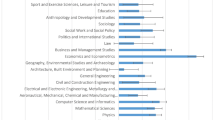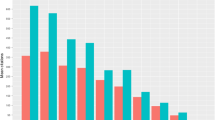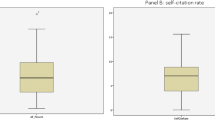Abstract
As bibliographical classification of published journal items affects the denominator in this equation, we investigated how the numerator and denominator of the impact factor (IF) equation were generated for representative journals in two categories of the Journal Citation Reports (JCR). We performed a full text search of the 1st-ranked journal in 2004 JCR category “Medicine, General and Internal” (New England Journal of Medicine, NEJM, IF = 38.570) and 61st-ranked journal (Croatian Medical Journal, CMJ, IF = 0.690), 1st-ranked journal in category “Multidisciplinary Sciences” (Nature, IF = 32.182) and journal with a relative rank of CMJ (Anais da Academia Brasileira de Ciencias, AABC, IF = 0.435). Large journals published more items categorized by Web of Science (WoS) as non-research items (editorial material, letters, news, book reviews, bibliographical items, or corrections): 63% out of total 5,193 items in Nature and 81% out of 3,540 items in NEJM, compared with 31% out of 283 items in CMJ and only 2 (2%) out of 126 items in AABC. Some items classified by WoS as non-original contained original research data (9.5% in Nature, 7.2% in NEJM, 13.7% in CMJ and none in AABC). These items received a significant number of citations: 6.9% of total citations in Nature, 14.7% in NEJM and 18.5% in CMJ. IF decreased for all journals when only items presenting original research and citations to them were used for IF calculation. Regardless of the journal’s size or discipline, publication of non-original research and its classification by the bibliographical database have an effect on both numerator and denominator of the IF equation.

Similar content being viewed by others
References
Garfield, E. (2006). The history and meaning of the journal impact factor. JAMA, 295, 90–93.
Seglen, P. O. (1997). Why the impact factor of journals should not be used for evaluating research. BMJ, 314, 498–502.
Joseph, K. S., & Hoey, J. (1999). CMAJ’s impact factor: Room for recalculation. CMAJ, 161, 977–978.
Joseph, K. S. (2003). Quality of impact factors of general medical journals. BMJ, 326, 283.
Adam, D. (2002). The counting house. Nature, 415, 726–729.
The PLoS Medicine Editors (2006). The impact factor game. PLoS Medicine, 3, e291.
Brown, H. (2007). How impact factor changed medical publishing—and science. BMJ, 334, 561–564.
Walter, G., Bloch, S., Hunt, G., & Fisher, K. (2003) Counting on citations: A flawed way to measure quality. MJA, 178, 280–281.
Lundberg, G. D. (2003). The “omnipotent” science citation index impact factor. MJA, 178, 253–254.
Nankivell, B. J., et al. (2003). The natural history of chronic allograft nephropathy. The New England Journal of Medicine, 349, 2326–2233.
Marusic, A., & Marusic, M. (2003). Teaching students how to read and write science: Mandatory course on scientific research and communication in medicine. Academic Medicine, 78, 1235–1239.
Martinson, B. C., Anderson, M. S., & de Vries, R. (2005). Scientists behaving badly. Nature, 435, 737–738.
Williams, G., & Hobbs R. (2007). Should we ditch impact factors? BMJ, 334, 568–569.
Dellavalle, R. P., Schilling, L. M., Rodriguez, M. A., Van de Sompel J., & Bollen J. (2007). Refining dermatology journal impact factors using PageRank. Journal of the American Academy of Dermatology, 57, 116–119.
Thomson Scientific (2005). Journal performance indicators. Available at: http://www.scientific.thomson.com/products/jpi/. Accessibility verified October 19, 2007.
Acknowledgements
Contributions: AM, MM, and NK conceived and designed the study; MR and RG collected all data, and analyzed them with AM. AM wrote the manuscript and MR, RG, NK and MM revised it for important intellectual content. All authors approved the final version of the manuscript for submission. Funding: This study was supported by the grant from the Ministry of Science, Education and Sports of the Republic of Croatia, No. 108-1080314-0245 to MM. Competing interests: AM and MM are Coeditors in Chief of the Croatian Medical Journal. NK is Book Review Editor fro the Croatian Medical Journal. None of them receives any pay for their work in the journal.
Author information
Authors and Affiliations
Corresponding author
Additional information
Preliminary results of the study were presented at the 2006 ORI Research Conference on Research Integrity, Tampa, FL, December 1–3, 2006.
Rights and permissions
About this article
Cite this article
Golubic, R., Rudes, M., Kovacic, N. et al. Calculating Impact Factor: How Bibliographical Classification of Journal Items Affects the Impact Factor of Large and Small Journals. Sci Eng Ethics 14, 41–49 (2008). https://doi.org/10.1007/s11948-007-9044-3
Received:
Accepted:
Published:
Issue Date:
DOI: https://doi.org/10.1007/s11948-007-9044-3




